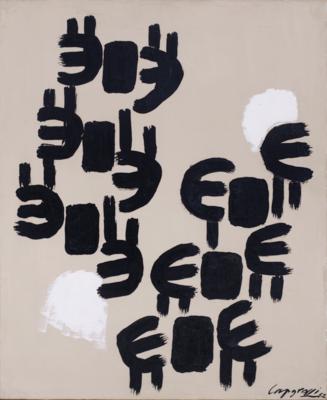Giuseppe Capogrossi *
(Rome 1900–1972)
Superficie 279, 1952, signed and dated, oil on canvas, 72 x 60 cm, framed
Provenance:
G. David Thompson Collection, Pittsburgh
Museum of Art, Carnegie Institute, Pittsburgh (label on the reverse)
Alcoa Collection of Contemporary Art, Pittsburgh
Sale Sotheby’s Milan, 30 May 1995, lot 272
Sale Finarte Milan, 4 October 2006, lot 468
Galleria d’Arte Mazzoleni, Turin
European Private Collection
Exhibited:
Pittsburgh, Alcoa Collection of Contemporary Art: An Exhibition of Works Acquired from the G. David Thompson Collection, Carnegie Institute Museum of Art, 12 January – 5 February 1967; travels to: Syracuse, Everson Museum of Art, 24 September – 15 October; Ithaca, Andrew Dickson White Museum of Art, Cornell University, 23 October – 19 November; Allentown, Allentown Art Museum, 3 – 24 December; Richmond, Art Association of Richmond, 7 - 28 January 1968; Davenport, Davenport Municipal Art Gallery, 11 February – 3 March 1968; Ann Arbor, University of Michigan, 17 March – 7 April 1968; Evansville, Evansville Museum of Arts & Sciences, 21 April – 12 May 1968; Binghamton, Roberson Center for the Arts & Sciences, 26 May – 16 June 1968; Montclair, Montclair Art Museum, 8 –29 September 1968; New Wilmington, Westminster College, 13 October – 3 November 1968; Tuscaloosa, University of Alabama, 17 November – 8 December 1968; Cambridge, Massachusetts Institute of Technology, 22 December 1968 - 12 January 1969; Albany, State University of New York, 26 January – 16 February 1969; Canton, St. Lawrence University, 2 - 23 March 1969; Tacoma, Tacoma Art Museum, 13 April – 4 May 1969; Austin, University of Texas, 1 - 27 July 1969; Los Angeles, Century City, Inc. 17 August – 7 September 1969; West Bend, West Bend Gallery of Fine Arts, 28 September – 19 October 1969; Youngstone, Butler Institute of American Art, 9 - 30 November 1969; Mobile, Mobile Art Gallery, 21 December 1969 - 11 January 1970; West Palm Beach, Norton Gallery of Art, 1 - 22 February 1970; Maryville, Maryville College, 24 April – 17 May 1970; El Paso, El Paso Museum of Art. 7 –28 June 1970, exh. cat. no. 9 with ill. (label on the reverse) *
Literature:
G. C. Argan (ed.), Capogrossi, Editalia, Rome, 1967, p. 149, no. 105 with ill.
Note:
As stated in the catalogue, this exhibition on works acquired from the J. David Thompson Collection had its first public showing at the Carnegie Institute Museum of Art, Pittsburgh. It is circulated under the auspices of The American Federation of Arts.
„The canvases of Capogrossi do not have the character of abstract art. But to what do the sings that appear in his pictures refer and how do they react on each other?
Inescapably we identify the marks in his canvases as the records of human activity. But what human activities? the individual marks resemble, especially when arranged in series, alphabets in languages that we cannot read, yet the appearance of sequence and order is so strong as to imply the presence of meaning.
There is repetition with different frequencies, like mysterious lists. Capogrossi's pictures are (...) like the footprints of birds in sand, they act as omens (...).
Roland Penrose, 1957, quoted in Giulio Carlo Argan (ed.), Capogrossi, Rome 1967, p. 22
Expert: Alessandro Rizzi
 Alessandro Rizzi
Alessandro Rizzi
+39-02-303 52 41
alessandro.rizzi@dorotheum.it
29.11.2023 - 18:00
- Odhadní cena:
-
EUR 100.000,- do EUR 150.000,-
Sledovat položku Sledování ukončit
Giuseppe Capogrossi *
(Rome 1900–1972)
Superficie 279, 1952, signed and dated, oil on canvas, 72 x 60 cm, framed
Provenance:
G. David Thompson Collection, Pittsburgh
Museum of Art, Carnegie Institute, Pittsburgh (label on the reverse)
Alcoa Collection of Contemporary Art, Pittsburgh
Sale Sotheby’s Milan, 30 May 1995, lot 272
Sale Finarte Milan, 4 October 2006, lot 468
Galleria d’Arte Mazzoleni, Turin
European Private Collection
Exhibited:
Pittsburgh, Alcoa Collection of Contemporary Art: An Exhibition of Works Acquired from the G. David Thompson Collection, Carnegie Institute Museum of Art, 12 January – 5 February 1967; travels to: Syracuse, Everson Museum of Art, 24 September – 15 October; Ithaca, Andrew Dickson White Museum of Art, Cornell University, 23 October – 19 November; Allentown, Allentown Art Museum, 3 – 24 December; Richmond, Art Association of Richmond, 7 - 28 January 1968; Davenport, Davenport Municipal Art Gallery, 11 February – 3 March 1968; Ann Arbor, University of Michigan, 17 March – 7 April 1968; Evansville, Evansville Museum of Arts & Sciences, 21 April – 12 May 1968; Binghamton, Roberson Center for the Arts & Sciences, 26 May – 16 June 1968; Montclair, Montclair Art Museum, 8 –29 September 1968; New Wilmington, Westminster College, 13 October – 3 November 1968; Tuscaloosa, University of Alabama, 17 November – 8 December 1968; Cambridge, Massachusetts Institute of Technology, 22 December 1968 - 12 January 1969; Albany, State University of New York, 26 January – 16 February 1969; Canton, St. Lawrence University, 2 - 23 March 1969; Tacoma, Tacoma Art Museum, 13 April – 4 May 1969; Austin, University of Texas, 1 - 27 July 1969; Los Angeles, Century City, Inc. 17 August – 7 September 1969; West Bend, West Bend Gallery of Fine Arts, 28 September – 19 October 1969; Youngstone, Butler Institute of American Art, 9 - 30 November 1969; Mobile, Mobile Art Gallery, 21 December 1969 - 11 January 1970; West Palm Beach, Norton Gallery of Art, 1 - 22 February 1970; Maryville, Maryville College, 24 April – 17 May 1970; El Paso, El Paso Museum of Art. 7 –28 June 1970, exh. cat. no. 9 with ill. (label on the reverse) *
Literature:
G. C. Argan (ed.), Capogrossi, Editalia, Rome, 1967, p. 149, no. 105 with ill.
Note:
As stated in the catalogue, this exhibition on works acquired from the J. David Thompson Collection had its first public showing at the Carnegie Institute Museum of Art, Pittsburgh. It is circulated under the auspices of The American Federation of Arts.
„The canvases of Capogrossi do not have the character of abstract art. But to what do the sings that appear in his pictures refer and how do they react on each other?
Inescapably we identify the marks in his canvases as the records of human activity. But what human activities? the individual marks resemble, especially when arranged in series, alphabets in languages that we cannot read, yet the appearance of sequence and order is so strong as to imply the presence of meaning.
There is repetition with different frequencies, like mysterious lists. Capogrossi's pictures are (...) like the footprints of birds in sand, they act as omens (...).
Roland Penrose, 1957, quoted in Giulio Carlo Argan (ed.), Capogrossi, Rome 1967, p. 22
Expert: Alessandro Rizzi
 Alessandro Rizzi
Alessandro Rizzi
+39-02-303 52 41
alessandro.rizzi@dorotheum.it
|
Horká linka kupujících
Po-Pá: 10.00 - 17.00
kundendienst@dorotheum.at +43 1 515 60 200 |
| Aukce: | Současné umění I |
| Typ aukce: | Sálová aukce s Live bidding |
| Datum: | 29.11.2023 - 18:00 |
| Místo konání aukce: | Wien | Palais Dorotheum |
| Prohlídka: | 18.11. - 29.11.2023 |
Další objekty umělce
-

Odhadní cena:
EUR 100.000,- do EUR 150.000,- -

Odhadní cena:
EUR 100.000,- do EUR 150.000,-
Všechny objekty umělce

